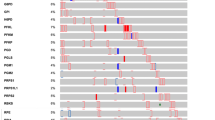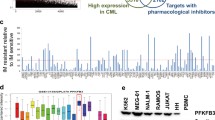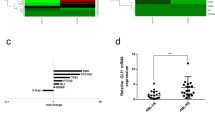Abstract
The main challenges in treating acute promyelocytic leukemia (APL) are currently early mortality, relapse, refractory disease after induction therapy, and drug resistance to ATRA and ATO. In this study, a computational chemogenomics approach was used to identify new molecular targets and drugs for APL treatment. The transcriptional profiles induced by APL were compared with those induced by genetic or chemical perturbations. The genes that can reverse the transcriptional profiles induced by APL when perturbed were considered to be potential therapeutic targets for APL. Drugs targeting these genes or proteins are predicted to be able to treat APL if they can reverse the APL-induced transcriptional profiles. To improve the target identification accuracy of the above correlation method, we plotted the functional protein association networks of the predicted targets by STRING. The results determined PML, RARA, SPI1, HDAC3, CEBPA, NPM1, ABL1, BCR, PTEN, FOS, PDGFRB, FGFR1, NUP98, AFF1, and MEIS1 to be top candidates. Interestingly, the functions of PML, RARA, HDAC3, CEBPA, NPM1, ABL, and BCR in APL have been previously reported in the literature. This is the first chemogenomics analysis predicting potential APL drug targets, and the findings could be used to guide the design of new drugs targeting refractory and recurrent APL.



Similar content being viewed by others
References
Coombs CC, Tavakkoli M, Tallman MS (2015) Acute promyelocytic leukemia: where did we start, where are we now, and the future. Blood Cancer J 5:e304. https://doi.org/10.1038/bcj.2015.25
Breccia M, Latagliata R, Cannella L, Minotti C, Meloni G, Lo-Coco F (2010) Early hemorrhagic death before starting therapy in acute promyelocytic leukemia: association with high WBC count, late diagnosis and delayed treatment initiation. Haematologica 95(5):853–854. https://doi.org/10.3324/haematol.2009.017962
Kayser S, Schlenk RF, Platzbecker U (2018) Management of patients with acute promyelocytic leukemia. Leukemia 32(6):1277–1294. https://doi.org/10.1038/s41375-018-0139-4
Wang L, Zhou GB, Liu P, Song JH, Liang Y, Yan XJ, Xu F, Wang BS, Mao JH, Shen ZX, Chen SJ, Chen Z (2008) Dissection of mechanisms of Chinese medicinal formula Realgar-indigo naturalis as an effective treatment for promyelocytic leukemia. Proc Natl Acad Sci U S A 105(12):4826–4831. https://doi.org/10.1073/pnas.0712365105
Ma H, Yang J (2015) Insights into the all-trans-retinoic acid and arsenic trioxide combination treatment for acute promyelocytic leukemia: a meta-analysis. Acta Haematol 134(2):101–108. https://doi.org/10.1159/000369242
Jalili M, Salehzadeh-Yazdi A, Mohammadi S, Yaghmaie M, Ghavamzadeh A, Alimoghaddam K (2017) Meta-analysis of gene expression profiles in acute promyelocytic leukemia reveals involved pathways. Int J Hematol Oncol Stem Cell Res 11(1):1–12
Yamamoto Y, Tsuzuki S, Tsuzuki M, Handa K, Inaguma Y, Emi N (2010) BCOR as a novel fusion partner of retinoic acid receptor alpha in a t(X;17)(p11;q12) variant of acute promyelocytic leukemia. Blood 116(20):4274–4283. https://doi.org/10.1182/blood-2010-01-264432
Abdelrahman M, El-Sayed MA, Hashem A, Abd Allah EF, Alqarawi AA, Burritt DJ, Tran LP (2018) Metabolomics and transcriptomics in legumes under phosphate deficiency in relation to nitrogen fixation by root nodules. Front Plant Sci 9:922. https://doi.org/10.3389/fpls.2018.00922
Suhling M, Wolke C, Scharf C, Lendeckel U (2018) Proteomics and transcriptomics in atrial fibrillation. Herzschrittmacherther Elektrophysiol 29(1):70–75. https://doi.org/10.1007/s00399-017-0551-x
Kazan K, Gardiner DM (2018) Transcriptomics of cereal-Fusarium graminearum interactions: what we have learned so far. Mol Plant Pathol 19(3):764–778. https://doi.org/10.1111/mpp.12561
Iorio F, Rittman T, Ge H, Menden M, Saez-Rodriguez J (2013) Transcriptional data: a new gateway to drug repositioning? Drug Discov Today 18(7–8):350–357. https://doi.org/10.1016/j.drudis.2012.07.014
Bredel M, Jacoby E (2004) Chemogenomics: an emerging strategy for rapid target and drug discovery. Nat Rev Genet 5(4):262–275. https://doi.org/10.1038/nrg1317
Kupershmidt I, Su QJ, Grewal A, Sundaresh S, Halperin I, Flynn J, Shekar M, Wang H, Park J, Cui W, Wall GD, Wisotzkey R, Alag S, Akhtari S, Ronaghi M (2010) Ontology-based meta-analysis of global collections of high-throughput public data. PLoS One 5(9). https://doi.org/10.1371/journal.pone.0013066
Lamb J, Crawford ED, Peck D, Modell JW, Blat IC, Wrobel MJ, Lerner J, Brunet JP, Subramanian A, Ross KN, Reich M, Hieronymus H, Wei G, Armstrong SA, Haggarty SJ, Clemons PA, Wei R, Carr SA, Lander ES, Golub TR (2006) The connectivity map: using gene-expression signatures to connect small molecules, genes, and disease. Science (New York, NY) 313(5795):1929–1935. https://doi.org/10.1126/science.1132939
Szklarczyk D, Morris JH, Cook H, Kuhn M, Wyder S, Simonovic M, Santos A, Doncheva NT, Roth A, Bork P, Jensen LJ, von Mering C (2017) The STRING database in 2017: quality-controlled protein-protein association networks, made broadly accessible. Nucleic Acids Res 45(D1):D362–d368. https://doi.org/10.1093/nar/gkw937
Hess F, Estrugo D, Fischer A, Belka C, Cordes N (2007) Integrin-linked kinase interacts with caspase-9 and -8 in an adhesion-dependent manner for promoting radiation-induced apoptosis in human leukemia cells. Oncogene 26(10):1372–1384. https://doi.org/10.1038/sj.onc.1209947
Ibanez M, Carbonell-Caballero J, Garcia-Alonso L, Such E, Jimenez-Almazan J, Vidal E, Barragan E, Lopez-Pavia M, LLop M, Martin I, Gomez-Segui I, Montesinos P, Sanz MA, Dopazo J, Cervera J (2016) The mutational landscape of acute promyelocytic leukemia reveals an interacting network of co-occurrences and recurrent mutations. PLoS One 11(2):e0148346. https://doi.org/10.1371/journal.pone.0148346
Mehdipour P, Santoro F, Botrugno OA, Romanenghi M, Pagliuca C, Matthews GM, Johnstone RW, Minucci S (2017) HDAC3 activity is required for initiation of leukemogenesis in acute promyelocytic leukemia. Leukemia 31(4):995–997. https://doi.org/10.1038/leu.2017.3
Chen Z, Chen SJ (1992) RARA and PML genes in acute promyelocytic leukemia. Leuk Lymphoma 8(4–5):253–260. https://doi.org/10.3109/10428199209051004
Cornic M, Agadir A, Degos L, Chomienne C (1994) Retinoids and differentiation treatment: a strategy for treatment in cancer. Anticancer Res 14(6a):2339–2346
Such E, Cervera J, Valencia A, Barragan E, Ibanez M, Luna I, Fuster O, Perez-Sirvent ML, Senent L, Sempere A, Martinez J, Martin-Aragones G, Sanz MA (2011) A novel NUP98/RARG gene fusion in acute myeloid leukemia resembling acute promyelocytic leukemia. Blood 117(1):242–245. https://doi.org/10.1182/blood-2010-06-291658
Reader JC, Meekins JS, Gojo I, Ning Y (2007) A novel NUP98-PHF23 fusion resulting from a cryptic translocation t(11;17)(p15;p13) in acute myeloid leukemia. Leukemia 21(4):842–844. https://doi.org/10.1038/sj.leu.2404579
Xia Y, Brown L, Yang CY, Tsan JT, Siciliano MJ, Espinosa R 3rd, Le Beau MM, Baer RJ (1991) TAL2, a helix-loop-helix gene activated by the (7;9)(q34;q32) translocation in human T-cell leukemia. Proc Natl Acad Sci U S A 88(24):11416–11420
Zhang LJ, Gan YM, Yu L (2015) Occurrence of BCR/ABL fusion gene in a patient with acute promyelocytic leukemia. Med Oncol 32(1):382. https://doi.org/10.1007/s12032-014-0382-0
Noguchi Y, Okazaki Y, Shimomura D, Yakushijin K, Yamamoto K, Matsuoka H, Minami H, Itoh T, Kawano S, Swaminathan S, Garg S, Madkaikar M, Gupta M, Jijina F, Ghosh K (2014) FLT3 and NPM-1 mutations in a cohort of acute promyelocytic leukemia patients from India. Int J Hematol 20(2):160–165. https://doi.org/10.4103/0971-6866.142884
McCulloch D, Brown C, Iland H (2017) Retinoic acid and arsenic trioxide in the treatment of acute promyelocytic leukemia: current perspectives. OncoTargets Ther 10:1585–1601. https://doi.org/10.2147/ott.s100513
Bloch DB, Nakajima A, Gulick T, Chiche JD, Orth D, de La Monte SM, Bloch KD (2000) Sp110 localizes to the PML-Sp100 nuclear body and may function as a nuclear hormone receptor transcriptional coactivator. Mol Cell Biol 20(16):6138–6146
Santana-Lemos BA, de Lima Lange AP, de Lira Benicio MT, Jose TD, Lucena-Araujo AR, Krause A, Thome CH, Rego EM (2011) The CEBPA gene is down-regulated in acute promyelocytic leukemia and its upstream promoter, but not the core promoter, is highly methylated. Haematologica 96(4):617–620. https://doi.org/10.3324/haematol.2010.028365
Heo SK, Noh EK, Kim JY, Jegal S, Jeong Y, Cheon J, Koh S, Baek JH, Min YJ, Choi Y, Jo JC (2018) Rhein augments ATRA-induced differentiation of acute promyelocytic leukemia cells. Phytomedicine 49:66–74. https://doi.org/10.1016/j.phymed.2018.06.027
Abramowitz J, Neuman T, Perlman R, Ben-Yehuda D (2017) Gene and protein analysis reveals that p53 pathway is functionally inactivated in cytogenetically normal acute myeloid leukemia and acute promyelocytic leukemia. BMC Med Genet 10(1):18. https://doi.org/10.1186/s12920-017-0249-2
Furugaki K, Pokorna K, Le Pogam C, Aoki M, Reboul M, Bajzik V, Krief P, Janin A, Noguera ME, West R, Charron D, Chomienne C, Pla M, Moins-Teisserenc H, Padua RA (2010) DNA vaccination with all-trans retinoic acid treatment induces long-term survival and elicits specific immune responses requiring CD4+ and CD8+ T-cell activation in an acute promyelocytic leukemia mouse model. Blood 115(3):653–656. https://doi.org/10.1182/blood-2007-08-109009
Qian X, He J, Zhao Y, Lin M (2016) Inhibition of p38 MAPK phosphorylation is critical for bestatin to enhance ATRA-induced cell differentiation in acute promyelocytic leukemia NB4 cells. Am J Ther 23(3):e680–e689. https://doi.org/10.1097/01.mjt.0000433950.01406.b3
Dunoyer-Geindre S, Rivier-Cordey AS, Tsopra O, Lecompte T, Kruithof EKO (2017) Effect of ATRA and ATO on the expression of tissue factor in NB4 acute promyelocytic leukemia cells and regulatory function of the inflammatory cytokines TNF and IL-1beta. Ann Hematol 96(6):905–917. https://doi.org/10.1007/s00277-017-2970-5
Alex AA, Ganesan S, Palani HK, Balasundaram N, David S, Lakshmi KM, Kulkarni UP, Nisham PN, Korula A, Devasia AJ, Janet NB, Abraham A, Srivastava A, George B, Padua RA, Chomienne C, Balasubramanian P, Mathews V (2018) Arsenic trioxide enhances the NK cell cytotoxicity against acute promyelocytic leukemia while simultaneously inhibiting its bio-genesis. Front Immunol 9:1357. https://doi.org/10.3389/fimmu.2018.01357
Lohrmann HP (1984) The problem of permanent bone marrow damage after cytotoxic drug treatment. Oncology 41(3):180–184. https://doi.org/10.1159/000225819
Koksal AR, Alkim C, Altinkaya E, Bugdaci MS, Ozdogan O, Boga S, Alkim H, Sokmen M (2011) Infliximab- and azathioprine-related severe neutropenia and thrombocytopenia in a case with Crohn’s disease. Turk J Gastroenterol 22(5):537–539
Yakar F, Yildiz N, Yakar A, Kilicaslan Z (2013) Isoniazid- and rifampicin-induced thrombocytopenia. Multidiscip Respir Med 8(1):13. https://doi.org/10.1186/2049-6958-8-13
Matthews GM, Mehdipour P, Cluse LA, Falkenberg KJ, Wang E, Roth M, Santoro F, Vidacs E, Stanley K, House CM, Rusche JR, Vakoc CR, Zuber J, Minucci S, Johnstone RW (2015) Functional-genetic dissection of HDAC dependencies in mouse lymphoid and myeloid malignancies. Blood 126(21):2392–2403. https://doi.org/10.1182/blood-2015-03-632984
Leung M, Wong K (1997) The combined differentiating effect of retinoic acid and vincristine on acute promyelocytic leukemia. Leuk Res 21(1):81–84
Szklarczyk D, Franceschini A, Wyder S, Forslund K, Heller D, Huerta-Cepas J, Simonovic M, Roth A, Santos A, Tsafou KP, Kuhn M, Bork P, Jensen LJ, von Mering C (2015) STRING v10: protein-protein interaction networks, integrated over the tree of life. Nucleic Acids Res 43(Database issue):D447–D452. https://doi.org/10.1093/nar/gku1003
Funding
This work was supported by a grant (No.2018 M643883) from China Postdoctoral Science Foundation and a grant (No.81773683) from the National Natural Science Foundation of China.
Author information
Authors and Affiliations
Corresponding authors
Ethics declarations
Conflict of interest
The authors declare that they have no competing interest.
Ethical approval
This article does not contain any studies with human participants or animals performed by any of the authors.
Informed consent
Informed consent was obtained from all individual participants included in the study.
Additional information
Publisher’s note
Springer Nature remains neutral with regard to jurisdictional claims in published maps and institutional affiliations.
Electronic supplementary material
ESM 1
(DOCX 204 kb)
Rights and permissions
About this article
Cite this article
Chen, S., Li, X., Ma, S. et al. Chemogenomics analysis of drug targets for the treatment of acute promyelocytic leukemia. Ann Hematol 99, 753–763 (2020). https://doi.org/10.1007/s00277-019-03888-4
Received:
Accepted:
Published:
Issue Date:
DOI: https://doi.org/10.1007/s00277-019-03888-4




